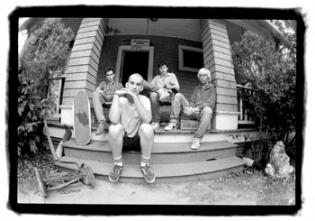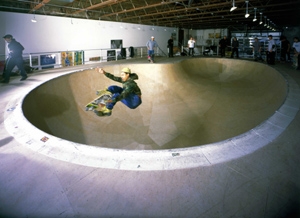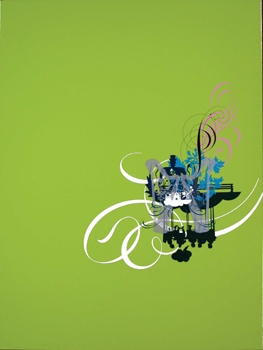Feature: Reviews
Beautiful Losers
- Yerba Buena Center for the Arts
- San Francisco
- Through October 10, 2004
Beautiful Losers tests the boundaries between the museum and the street through an exploration of the influence of street-culture in art since the 1980s. Outside, in the windows both along Mission St. and at the entrance to the Yerba Buena Center for the Arts, one sees figures spray-painting the walls that reveal themselves only on second-glance to be mannequins in an untitled installation by Josh Lazcano and Barry McGee. Just inside, skateboard wheels thunder across Free Basin, a swimming pool sized skate-bowl constructed by the art-collective SIMPARCH; and skateboarders, typically relegated to thrashing the steps outside, wander the halls of the museum wearing helmets. On one wall of the front gallery hangs Money to Loan a billboard-sized painting by Margaret Kilgallen that might just as well be found in the Mission’s Clarion Alley. And the show is rich with photo-documents of graffiti projects, including Brian Donnelly’s (aka KAWS) manipulation of telephone booth and bus-stop posters.
With styles drawn from hip-hop, comic books, and punk, the show establishes a clear connection between street-culture and adolescent rebellion—revealing street art to be produced largely by young people without private spaces of their own, and identifying this defiant energy to be the principal source of its inspiration in contemporary art. Terry Richardson’s pornographic photographs bear the mark of this Oedipal conflict through his obvious enjoyment of their deviance. And Chris Johanson entertains an unreserved childishness in his untitled installation, which presents a cacaphonous circle of video-monitors mounted in a wooden mock-up of a teepee, with adults dressed in monotone jumpers banging chaotically on drums against crayon-colored backgrounds. Johanson’s piece is hilarious (if somewhat silly) and presents a welcome departure from the didactic moralizing, which plagues so much of his painting.
But the emphasis on youth-culture degenerates into mere hipsterism in the work of artists such as Ryan McGinley and pro-skater turned artist Ed Templeton, who present pictures of their purportedly counter-cultural cohorts as if their rock-and-roll lifestyles were enough to make the work compelling. And the work of Templeton and others for corporations including Nike, Geffen Records, and the Gap raises questions concerning street-art’s pretenses to authenticity and the commerce of cool that fuels contemporary capitalism.
The Yerba Buena Center for the Arts is open Thursday-Saturday, 12-8pm, Sunday, Tuesday, Wednesday 12-5pm. The address is 701 Mission Street (at Third, San Francisco. Admission is $6 adults; $3 seniors, disabled & amp; students. Free first Tuesday of the month. For more information, call 415.978.2700.



